 |
||
 |
The
goal of CWRAM is to serve the state of Texas in the following ways:
· To conduct
research on techniques and Best Management Practices (BMPs) for assessing
and managing watersheds and reservoirs, addressing current and emerging
problems and issues. Importance of Watersheds Watersheds and recharge areas are very appropriate units of management for protection of reservoirs and water quality. Reservoirs currently provide 55% of the drinking water for the citizens of Texas and serve as significant sources of water for agriculture and industry, as well as providing recreation and enjoyment. Maintaining these services is becoming increasingly more difficult and complex. Rural watersheds are rapidly urbanizing, often changing the quantity and quality of water entering the reservoirs. Increased
recreational use of reservoirs causes a variety of problems ranging from
personal safety issues to shoreline erosion. Introduction of exotic
species, such as Hydrilla, pose considerable threats to the ecological
balance and recreational uses of reservoirs. Fertilizer runoff from
urban neighborhoods and agricultural fields can cause excessive algae
growth in reservoirs, producing taste and odor problems in our drinking
water. The demand for water by large urban areas often conflict with
the needs of industry and agriculture. University of North Texas and Watershed Research For over 60 years the University of North Texas (UNT) has had an active reservoir and water quality teaching and research program. The Institute of Applied Sciences at UNT (http://ias.unt.edu) has conducted problem-solving research on watersheds and reservoirs for over 20 years. For over two decades UNT has worked with Texas water suppliers, conducting assessments and management plans for maintaining the State’s water quality. UNT has an excellent record of educating professionals in environmental resource management. The University offers masters and doctoral degrees in environmental science and in more traditional biology (http://biology.unt.edu). It also offers a masters degree in Applied Geography, with emphasis in planning, policy and GIS (http://geography.unt.edu). Faculty and staff have strong credentials and experience in limnology, remote sensing, GIS, environmental engineering, policy and planning, aquatic botany, wetland science, aquatic and sediment toxicology, groundwater hydrology, soils and geology, environmental modeling, stream and mammalian ecology, statistics, information management and environmental education. For more information, contact: Dr. Ken
Dickson, Dr. Tom Waller or Dr. Tom LaPoint at 940-56502694 |
|
|
|
||
|
|
||